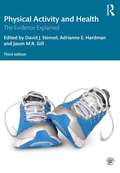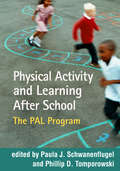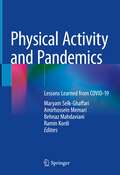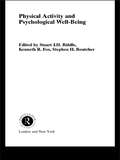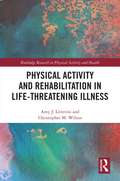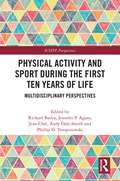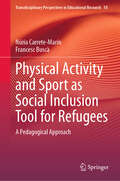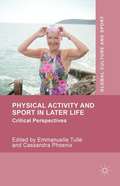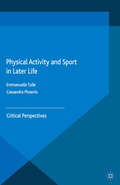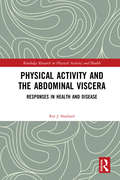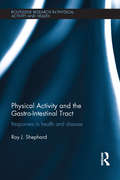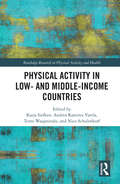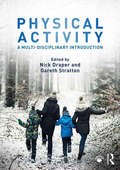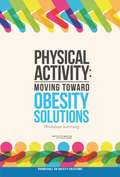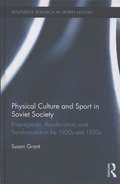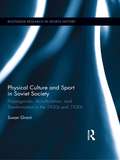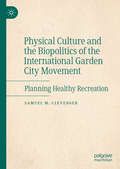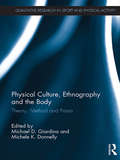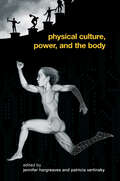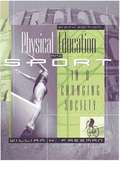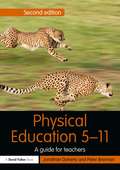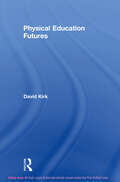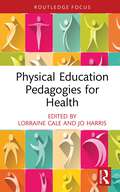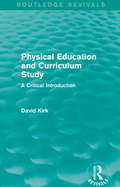- Table View
- List View
Physical Activity and Health: The Evidence Explained
by Adrianne E. Hardman David J. Stensel Jason M.R. GillPhysical Activity and Health explains clearly, systematically and in detail the relationship between physical activity, health and disease, and examines the role of exercise in the prevention and management of a wide range of important conditions. Now in a fully updated and expanded third edition, this is the most complete and engaging textbook on the subject. It offers a balanced examination of the latest evidence linking levels of physical activity with the risk of mortality, cardiovascular diseases, diabetes, obesity, cancer, osteoporosis and dementia. Designed to help the reader evaluate the quality of the evidence, the book includes an invaluable discussion of common study designs and the inherent difficulties of measuring physical activity. It examines the evidence in relation to child and adolescent health, older adults, hazards of exercise, sedentary behaviour, public health policy and, in a new chapter, mental health, and an epilogue considers the emerging evidence regarding the significance of physical activity and COVID-19. Containing chapter summaries, study tasks, guides to supplementary reading, a glossary of key terms and an abundance of figures and tables, Physical Activity and Health is an essential course text, and important reading for undergraduate, masters and postgraduate research students of sport and exercise science, public health, physical therapy, medicine and nursing. This third edition is supported by an updated companion website featuring self-test questions, PowerPoint slides, learning activities and website links.
Physical Activity and Learning After School: The PAL Program
by Paula J. Schwanenflugel Phillip D. TomporowskiEvery school day, more than 10 million children attend after-school programs in the United States. This book provides a research-based blueprint for offering students in grades 1-5 innovative programming that combines intensive physical activity and social-emotional skills development with academic enrichment in reading, mathematics, and social studies. Presented is an integrative approach that has been developed and tested in high-poverty schools. The volume includes explicit guidance for setting up a program, implementing cognitively engaging physical games and learning activities, working effectively with mixed-age groups, and monitoring outcomes. Reproducible forms and lesson plans can be downloaded and printed in a convenient 8 1/2" x 11" size.
Physical Activity and Pandemics: Lessons Learned from COVID-19
by Ramin Kordi Maryam Selk-Ghaffari Amirhossein Memari Behnaz MahdavianiThe pandemic of COVID-19 has caused public health-related, and economic consequences regarding lifestyles. Due to social distancing strategies, physical inactivity has increased in various societies, which might lead to an increase in the burden of non-communicable diseases in long term. The health benefits of physical activity consist of a wide range, including physical, mental, and social dimensions. Therefore, this book discusses whether engaging in regular physical activity is effective in preventing COVID-19 infection, reducing the severity of symptoms, reducing mortality, or eliminating COVID-19 complications.The book will serve as a practical guideline for public health experts and physicians. It covers COVID-19 and physical inactivity prevalence in different regions, physical activity and risk of COVID-19 infection, physical activity and course of COVID-19 infection including disease severity, hospitalization rate, ICU admission, and mortality, physical activity as a vaccine booster in different populations, post- COVID-19 physical rehabilitation, and strategies for enhancing physical activity in the COVID-19 pandemic.
Physical Activity and Psychological Well-Being
by Stuart J. H. Biddle Kenneth R. Fox Stephen H. BoutcherThe 'feel-good' effect of physical activity is widely reported among participants. Physical Activity and Psychological Well-Being represents a research consensus on the relationship between physical activity and aspects of mental health, providing an overview of the case for the role of exercise in the promotion of psychological well-being. Topics covered include: * anxiety and stress* depression* mood and emotion* self-perceptions and self-esteem* cognitive functioning and ageing* psychological dysfunction This book is invaluable reading for students and researchers working in the exercise, sport and health sciences, and for health and clinical psychologists. It is also a foundation text for health promotion and health service professionals, particularly those working in the area of mental health.
Physical Activity and Rehabilitation in Life-threatening Illness (Routledge Research in Physical Activity and Health)
by Amy J. Litterini Christopher M. WilsonThis book is a comprehensive summary of the recommendations for best practice, and current evidence, for physical activity and rehabilitation of functional deficits in individuals with end-stage diseases. While advances in technology have afforded us the opportunity to live longer lives, it has also demanded an expansion of focus of medical interventions towards palliative care to enhance the quality of life. Exercise and healthcare professionals must strive to broaden their perspectives to provide for the unique needs of these individuals, and to successfully engage with them, to achieve the most positive outcomes throughout the entire continuum of care. Healthcare providers play a critical role in advocating for care to allow individuals to remain physically active for as long as possible, even in the face of declining health. Finally, due to the increasing and progressively emergent healthcare utilization required by these individuals, a significant cost burden is experienced by healthcare systems, patients, families, and payers. There is evidence of substantial protective effects of physical activity, prevention, safety, and rehabilitative procedures to reduce hospital readmissions, reduce length of stay, and assist in avoiding unwarranted or unnecessary diagnostic tests or procedures. Physical activity has been proven to have a substantial impact and protective effects on virtually all medical conditions. During curative management, but especially during transitional phases to palliative care, other strategies need enhanced consideration to complement the existing plan of care and help to improve patient’s quality of life. Ideally, physical medicine would be at the forefront of allowing individuals to live their best life until the very end. Physical Activity and Rehabilitation in Life-threatening Illness is key reading for academics and policy makers in physical activity, international exercise, wellness and rehabilitation, and related disciplines, as well as research-focused clinicians in settings where patients with advanced illness are frequently encountered.
Physical Activity and Sport During the First Ten Years of Life: Multidisciplinary Perspectives (ICSSPE Perspectives)
by Bailey RichardEvidence suggests that the first 10 or so years of life create the foundation for subsequent participation in recreational and health-related physical activity. This book brings together researchers and practitioners with expertise in issues related to physical activity, physical education, and sport during the primary/elementary phase of schooling, to explore these important issues. Combining inter-disciplinary perspectives, the book addresses the inherent complexity of researching with young children. It looks at the evidence on development during the first 10 years and how that evidence relates to physical activity and to sport, in pre-school, school and out of school. Finally, the book offers a series of national case studies, from Asia, Europe and Africa, demonstrating the importance of age-appropriate sport and physical activity. This is important reading for any student, researcher, educator or policy maker with an interest in physical activity and health, education in the early years or at primary/elementary level, paediatric exercise science, or youth sport.
Physical Activity and Sport as Social Inclusion Tool for Refugees: A Pedagogical Approach (Transdisciplinary Perspectives in Educational Research #10)
by Núria Carrete-Marín Francesc BuscàThis book addresses the social benefits of physical activity and sport in promoting the social and educational inclusion of refugees living in Europe in line with Sustainable Development Goals 4, 10 and 16. It provides a theoretical framework supported by evidence obtained from a case study in the Spanish context. The book demonstrates how universities and formal and non-formal educational institutions, by means of service-learning activities managed by physical and social educators, enable refugees and students to practice physical activity, develop further learning and establish stable social networks. It shows how a pedagogical approach to physical activity can improve relationships between students and refugees and promote inclusion of all. It discusses the value of diversity in education and educational research, as well as transdisciplinarity in new educational and research approaches.
Physical Activity and Sport in Later Life: Critical Perspectives (Global Culture and Sport Series)
by Emmanuelle Tulle Cassandra PhoenixPhysical Activity and Sport in Later Life.
Physical Activity and Sport in Later Life: Critical Perspectives (Global Culture and Sport Series)
by Emmanuelle Tulle Cassandra PhoenixThis volume addresses key issues such as the cultural and discursive context in which physical activity is discussed; the process of becoming physically active; the role of care settings in enabling physical activity; pleasure; gender; and place and space.
Physical Activity and the Abdominal Viscera: Responses in Health and Disease (Routledge Research in Physical Activity and Health)
by Roy J. ShephardPhysical Activity and the Abdominal Viscera is the first book to examine the response of the visceral organs to acute and chronic physical activity, in cases of both health and disease. Bringing together a previously disparate body of research, Professor Roy Shephard sets out the physiology, function during exercise, pathology of disease, and role of physical activity in preventing and managing disease in the visceral organs. Working systematically through the viscera, the book first identifies the response to exercise and pathologies of the liver, gall bladder and biliary tract, then goes on to examine the function of the kidneys and bladder, and finally covers issues including the spleen, sickle cell disease and prostate cancer. Providing a clear and well-structured guide to the relationship between the visceral organs and physical activity, Physical Activity and the Abdominal Viscera is a vital reference text for academics and upper-level students in sports medicine and clinical exercise physiology, and for health professionals in preventive medicine.
Physical Activity and the Gastro-Intestinal Tract: Responses in health and disease (Routledge Research in Physical Activity and Health)
by Roy J. ShephardThe organs of the gastro-intestinal tract play an essential role in sustained physical activity, but their consideration in exercise-related literature has, to this point, been limited. Physical Activity and the Gastro-Intestinal Tract is the first book to explain the function and response to exercise of the gastro-intestinal system, in cases of both health and disease, and helps to shed light on the role they play in acute and chronic exercise. Professor Roy Shephard synthesises previously disparate research to explain the physiology, function, pathology of disease and role of exercise in both health and chronic disease, covering topics including: physical activity and the oesophagus gastro-duodenal function and physical activity physical activity and peptic ulcers physical activity and gastro-oesophageal cancers physical activity and the function of the large bowel physical activity and chronic intestinal inflammation. With each chapter including a thorough bibliography and signposts to further reading, Physical Activity and the Gastro-Intestinal Tract provides a complete reference for understanding how exercise affects the function of the digestive organs. It is an important text for academics and upper-level students in sports medicine and exercise physiology, and for health professionals in preventative medicine.
Physical Activity in Low- and Middle-Income Countries (Routledge Research in Physical Activity and Health)
by Nico Schulenkorf Katja Siefken Andrea Ramirez Varela Temo WaqanivaluThis book critically evaluates the complex relations between physical activity, health imperatives and cultural and social opportunities in low- and middle-income countries (LMICs). The book explores the uncertainty of knowledge around physical activity behavior and its distinctive meanings in LMIC contexts, the factors influencing physical activity, and how populations across the world understand and live the concept of physical activity. It discusses the key challenges and opportunities for sustaining physical activity within geographically and culturally diverse contexts of LMICs; introduces the reader to contemporary global physical activity approaches, models and policies; and presents case studies from around the world, including Asia, Africa, South America, the Pacific and Europe. Overall, the text relates theory to practical examples to facilitate a better understanding of physical activity in context, emphasizes the need for targeted, context-specific and locally relevant interventions to create PA-enabling environments in LMICs, and highlights the role of a range of stakeholders, including policy makers and urban planners, sport and recreation services, mass media, educators and the civil society in shaping population physical activity levels. Taken together, this edited volume brings together the latest research on PA in LMICs from around the world, informs and directs future research and necessary policy change towards the sustainable integration of PA opportunities, and seeks to ultimately foster and promote population-based PA in LMIC settings. By presenting empirical data and policy recommendations, this text will appeal to scholars, researchers and practitioners with an interest in physical activity research, public health, health promotion, sociology of sport, and sports sciences in LMICs, as well as policy makers and experts working in health promotion, public health, sports and fitness, but also in the urban planning and infrastructure and governmental industries.
Physical Activity in Natural Settings: Green and Blue Exercise
by Aoife A. Donnelly Tadhg E. MacIntyreExercise interactions with green and blue spaces offer low-cost, non-invasive solutions to public health challenges—particularly around mental health and obesity—and issues around environmental sustainability. Physical Activity in Natural Settings brings together multi-disciplinary, international research on physical activity, health and the natural environment, offering evidence-based guidance on implementing nature-based solutions at individual, patient and population levels. Divided over four sections, the book assesses the current research landscape, explores the underlying psychological and physiological mechanisms of the benefits of green exercise, details applied examples of physical activity in natural settings, and suggests future directions for research and practice. It features contributions from experts from around the world and covers topics including: Self-determination, nature and wellbeing Visual cognition and multisensory stimuli Nature’s role in growing resilience Physical education and nature Mindfulness and green exercise Positive psychology and pro-environmental behaviour Timely and prescient, and showcasing real-life examples of green exercise prescription, Physical Activity in Natural Settings is fascinating and important reading for any students or researchers in the psychology or physiology of physical activity and health, physical education or outdoor studies, and policy-makers and health professionals.
Physical Activity: A Multi-disciplinary Introduction
by Nick Draper Gareth StrattonPhysical activity and its relationship to health is one of the great issues of our age. The causes of, and solutions to, physical inactivity are complex and multi-dimensional, and therefore the subject needs to be studied and understood from a variety of perspectives. This is the first textbook to provide a truly multi-disciplinary introduction to physical activity studies. Offering a complete foundation to the subject, it covers the basics of every core discipline from biochemistry, public health and biomechanics to physiology, sport psychology and sociology. It introduces a full range of topics across the physical activity curriculum, including behaviour change, motor skill development, nutrition, exercise prescription, public health policy, and physical education, providing a well-balanced and international perspective on each important issue. There is also a strong emphasis throughout the book on the practical, applied dimensions of physical activity, including innovative approaches to promotion and intervention tailored to every age range and environment. Physical Activity: A Multi-disciplinary Introduction is an indispensable companion to any course or degree programme with an emphasis on physical activity and health. A variety of exclusive eResources to aid teaching and learning are also available via the Routledge website.
Physical Activity: Workshop Summary
by Leslie PrayIn 2008, the U. S. federal government issued fully approved physical activity guidelines for the first time. The idea that physical activity impacts health can be traced as far back as Hippocrates, and the science around the linkages between physical activity and health has continuously accumulated. On April 14-15, 2015, the Institute of Medicine's Roundtable on Obesity Solutions held a 2-day workshop to explore the state of the science regarding the impact of physical activity in the prevention and treatment of overweight and obesity and to highlight innovative strategies for promoting physical activity across different segments of the population. This report summarizes the presentations and discussions from this workshop.
Physical Culture and Sport in Soviet Society: Propaganda, Acculturation, and Transformation in the 1920s and 1930s
by Susan GrantFrom its very inception the Soviet state valued the merits and benefits of physical culture, which included not only sport but also health, hygiene, education, labour and defence. Physical culture propaganda was directed at the Soviet population, and even more particularly at young people, women and peasants, with the aim of transforming them into ideal citizens. By using physical culture and sport to assess social, cultural and political developments within the Soviet Union, this book provides a new addition to the historiography of the 1920s and 1930s as well as to general sports history studies.
Physical Culture and Sport in Soviet Society: Propaganda, Acculturation, and Transformation in the 1920s and 1930s (Routledge Research in Sports History Series #2)
by Susan GrantFrom its very inception the Soviet state valued the merits and benefits of physical culture, which included not only sport but also health, hygiene, education, labor and defense. Physical culture propaganda was directed at the Soviet population, and even more particularly at young people, women and peasants, with the aim of transforming them into ideal citizens. By using physical culture and sport to assess social, cultural and political developments within the Soviet Union, this book provides a new addition to the historiography of the 1920s and 1930s as well as to general sports history studies.
Physical Culture and the Biopolitics of the International Garden City Movement: Planning Healthy Recreation
by Samuel M. ClevengerThis book revisits the history of the international garden city town planning movement in the early twentieth century, focusing on the significance of various forms of 'physical culture' - sport, recreation, leisure, and other active body practices - within garden city planning discourse and the development of some of the first garden city communities in the United Kingdom and United States.
Physical Culture, Ethnography and the Body: Theory, Method and Praxis (Qualitative Research in Sport and Physical Activity)
by Michael D. Giardina Michele K. DonnellyThe corporeal turn toward critical, empirically grounded studies of the body is transforming the way we research physical culture, most evidently in the study of sport. This book brings together original insights on contemporary physical culture from key figures working in a variety of disciplines, offering a wealth of different theoretical and philosophical ways of engaging with the body while never losing site of the material form of the research act itself. Contributors spanning the disciplines of sociology, anthropology, communications, and sport studies highlight conceptual, methodological, and empirical approaches to the body that include observant-participation, feminist ethnography, autoethnography, physical cultural studies, and phenomenology. They provide vivid case studies of embodied research on topics including basketball, boxing, cycling, dance, fashion modelling and virtual gaming. This international collection not only reflects on the most important recent developments in embodied research practices, but also looks forward to the continuing importance of the body as a focus for research and the possibilities this presents for studies of the active, moving body in physical culture and beyond. Physical Culture, Ethnography and the Body: Theory, method and praxis is fascinating reading for all those interested in physical cultural studies, the sociology of sport and leisure, physical education or the body.
Physical Culture, Power, and the Body (Routledge Critical Studies in Sport)
by Patricia Vertinsky Jennifer HargreavesDuring the past decade, there has been an outpouring of books on 'the body' in society, but none has focused as specifically on physical culture - that is, cultural practices such as sport and dance within which the moving physical body is central. Questions are raised about the character of the body, specifically the relation between the ‘natural’ body, the ‘constructed’ body and the ‘alien’ or ‘virtual’ body. The themes of the book are wide in scope, including: physical culture and the fascist body sport and the racialised body sport medicine, health and the culture of risk the female Muslim sporting body, power, and politics experiencing the disabled sporting body embodied exhibitions of striptease and sport the social logic of sparring sport, girls and the neoliberal body. Physical Culture, Power, and the Body aims to break down disciplinary boundaries in its theoretical approaches and its readership. The author’s muli-disciplinary backgrounds, demonstrate the widespread topicality of physical culture and the body.
Physical Education & Sport in a Changing World
by William H. FreemanThis sixth edition of Society examines the developing subdisciplines and interests in the broad field of physical education, sport, exercise science, and kinesiology.
Physical Education 5-11: A guide for teachers (Primary 5-11 Series)
by Jonathan Doherty Peter BrennanPhysical Education 5-11 is about lighting or relighting a fire in all those who have the privilege and the responsibility of teaching children physical education in Primary schools today. It is written at a time of great change: a revised Primary curriculum; an increased drive to raise achievement and potentially a narrowing of curricular scope in favour of literacy and numeracy. It is little wonder that teachers are looking for certainty and answers to questions such as:- What do I teach in PE? What do I need to know about children’s development? What does good teaching look like in PE? How can I assess such a practical subject effectively? ? This new and updated edition provides answers to those questions, covers issues in Physical Education and provides a wealth of practical advice on teaching across the stages of the new 2014 curriculum. Drawing upon the author’s experiences as a teacher, coach, lecturer and adviser, it delivers a justification for PE as an essential element in the Primary curriculum, imbues a theory into practice approach that provides readers with clarity, instils confidence and offers a licence to teach all practical aspects of PE effectively and creatively underpinned by knowledge of children’s development, their learning and the critical professional issues in PE today. This book is the essential companion to inform and inspire students and practising teachers in this most dynamic and exciting of subjects!
Physical Education Futures (Routledge Studies in Physical Education and Youth Sport)
by David KirkCan we imagine a future in which physical education in schools no longer exists? In this controversial and powerful meditation on physical education, David Kirk argues that a number of different futures are possible. Kirk argues that multi-activity, sport-based forms of physical education have been dominant in schools since the mid-twentieth century and that they have been highly resistant to change. The practice of physical education has focused on the transmission of de-contextualised sport-techniques to large classes of children who possess a range of interests and abilities, where learning rarely moves beyond introductory levels. Meanwhile, the academicization of physical education teacher education since the 1970s has left teachers less well prepared to teach this programme than they were previously, suggesting that the futures of school physical education and physical education teacher education are intertwined. Kirk explores three future scenarios for physical education, arguing that the most likely short-term future is ‘more of the same’. He makes an impassioned call for radical reform in the longer-term, arguing that without it physical education faces extinction. No other book makes such bold use of history to interrogate the present and future configurations of the discipline, nor offers such a wide-ranging critique of physical culture and school physical education. This book is essential reading for all serious students and scholars of physical education and the history and theory of education.
Physical Education Pedagogies for Health (Routledge Focus on Sport Pedagogy)
by Lorraine Cale Jo HarrisThis book focuses on health within physical education (PE) and specifically on PE pedagogies for health. It gives practitioners and students the knowledge, understanding, skills and confidence to employ effective health pedagogies and practices in their work, and to promote healthy, active lifestyles within their PE curricula. Drawing on cutting-edge research, the book highlights key pedagogical issues and debates concerning the delivery of health in PE, and their implications for practice, such as in policy and curriculum development. It explores recent recommendations and developments in PE pedagogies for health which have been shown to enhance, or have the potential to enhance, practice in the area, as well as future opportunities for doing so. It provides practical tools that bridge the gap between research and application, including learning activities and questions that encourage the reader to reflect on their own professional practice and identify actions for developing their own pedagogy, practice and curricula in the area. This is essential reading for all PE teachers, coaches working with children or young people, teacher and coach educators, and trainee teachers and coaches.
Physical Education and Curriculum Study: A Critical Introduction (Routledge Revivals)
by David KirkThe Curriculum is the focal point for the study of educational practice. It is the area in which individual, group and societal needs and interests meet and is consequently the source of much friction and contention. This book, first published in 1988, introduces students to some of the major points of debate; in particular, the role of curriculum-based study in the development of physical education and the credibility of the subject as an educational activity. David Kirk emphasises the beneficial effects of physical education and suggests ways in which instructive programmes can be created. A practical and interesting title, this reissue will be of particular value to students and teachers of sport science, and educational practitioners more generally.
